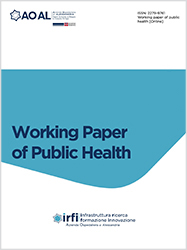Scanning Electron Microscopy coupled with Energy Dispersive Spectroscopy applied to the analysis of fibers and particles in tissues from colon adenocarcinomas

Accepted: 25 January 2023
All claims expressed in this article are solely those of the authors and do not necessarily represent those of their affiliated organizations, or those of the publisher, the editors and the reviewers. Any product that may be evaluated in this article or claim that may be made by its manufacturer is not guaranteed or endorsed by the publisher.
Background: The mineral phases regulated as “asbestos” have a well-known role in disease development in the respiratory tract (e.g. mesothelioma, pulmonary carcinoma, asbestosis), but it is not clear their role in cancer development in other body sites, as in colon-rectum tract. Materials and Methods: In this work, seven colon tissues (healthy and neoplastic portions and an area “bridge” between them) from patients affected by colon adenocarcinoma – and living in a highly asbestos-polluted area - have been digested and the inorganic residual components collected on polycarbonate filters analyzed by means of Scanning Electron Microscopy (SEM) with annexed an Energy Dispersive Spectroscopy (EDS) for elemental chemical analysis. Results: The obtained results allow us to characterize serpentine phases in two of the seven analyzed patients. Moreover, calcium phosphate phases and other metal-rich particles have been observed inside the samples. Conclusions: SEM/EDS allowed us to morphologically observe and chemically analyze not only asbestos phases, but also other inorganic particles inside tissues deriving from colon adenocarcinomas.
Park EK, Takahashi K, Jiang Y, et al. Elimination of asbestos use and asbestos-related diseases: an unfinished story. Cancer Sci. 2012;103:1751-5. DOI: https://doi.org/10.1111/j.1349-7006.2012.02366.x
Legge 257 del marzo 1992. Norme relative alla cessazione dell'impiego dell'amianto. S. Ord. alla G.U.N. 087 Serie Generale Parte Prima del 13/04/1992 Supplemento 064 del 13/04/1992 - Legge 27 marzo 1992, n. 257.
Decreto Ministeriale del 06/09/1994, Normative e metodologie tecniche di applicazione dell’art.6, comma 3, e dell’art.12, comma 2, della legge 27 marzo 1992, n. 257, relativa alla cessazione dell’impiego dell’amianto, GUI –Supplemento Ordinario n°220.
Decreto legislativo n° 277 del 15 agosto 1991, Attuazione delle direttive n. 80/1107/CEE, n. 82/605/CEE, n. 83/477/CEE, n. 86/188/CEE e n. 88/642/CEE, in materia di protezione dei lavoratori contro i rischi derivanti da esposizione ad agenti chimici, fisici e biologici durante il lavoro, a norma dell'articolo 7 della legge 30 luglio 1990, n° 212.
Decreto Legislativo 152/2006, Norme in materia ambientale, GUI n° 88.
Decreto Legislativo n° 81 del 9 aprile 2008, Attuazione dell'articolo 1 della legge 3 agosto 2007, n. 123, in materia di tutela della salute e della sicurezza nei luoghi di lavoro, G.U. n° 101 del 30 aprile 2008.
Directive 2003/18/EC (2003) of the European Parliament and of the Council of 27 March 2003 amending Council Directive 83/477/EEC on the protection of workers from the risks related to exposure to asbestos at work, 2003, OJ L 97, 48–52.
Di Maggio R, Barone P, Pettinelli E, et al. Geologia forense. Introduzione alle geoscienze applicate alle indagini giudiziarie. Palermo, Italy: Dario Flaccovio Editore; 2013. 465 pp.
Hawthorne FC, Oberti R, Della Ventura G, Mottana A. Amphiboles: crystal chemistry, occurrence, and health issues. In: Reviews in Mineralogy and Geochemistry (Rosso JJ ed.) vol. 67; Chantilly, VA, USA: Mineralogical Society of America; 2007. 545 pp. DOI: https://doi.org/10.1515/9781501508523
Palmieri EL, Parotto M. Il globo terrestre e la sua evoluzione. 2nd ed. Bologna, Italy: Zanichelli; 2017.
Pauling L. The nature of the chemical bond and the structure of molecules and crystals, An introduction to modern structural chemistry. Ithaca, NY, USA: Cornell Univ Press: 1960. 664 pp.
Putnis A. Introduction to mineral sciences. Cambridge, UK: Cambridge University Press; 1992. 480 pp. DOI: https://doi.org/10.1017/CBO9781139170383
Deer WA, Howie RA, Zussman J. Introduzione ai minerali che costituiscono le rocce. Bologna, Italy: Zanichelli; 1994. 680 pp.
World Health Organization (WHO). Environmental Health Criteria 53 – Asbestos and other natural mineral fibres, International programme for chemical safety. Geneva, Switzerland: WHO; 1986. Available from: https://apps.who.int/iris/bitstream/handle/10665/37190/9241541938-eng.pdf
Solbes E, Harper RW. Biological responses to asbestos inhalation and pathogenesis of asbestos-related benign and malignant disease. J. Investig. Med. 2018;66:721-7. DOI: https://doi.org/10.1136/jim-2017-000628
International Agency for Research on Cancer (IARC). Asbestos (chrysotile, amosite, crocidolite, tremolite, actinolite, and anthophyllite). In IARC monographs on the evaluation of carcinogenic risks to humans, Volume 100C; Lyon, France: IARC; 2012; pp. 219–309.
Fazzo L, Binazzi A, Ferrante D, et al. Burden of mortality from asbestos-related diseases in Italy. Int. J. Environ. Res. Public Health. 2021;18:10012. DOI: https://doi.org/10.3390/ijerph181910012
Wadowski B, De Rienzo A, Bueno R. The molecular basis of malignant pleural mesothelioma. Thorac. Surg. Clin. 2020;30:383-93. DOI: https://doi.org/10.1016/j.thorsurg.2020.08.005
Wilk E, Krówczyńska M. Malignant mesothelioma and asbestos exposure in Europe: evidence of spatial clustering. Geospat. Health. 2021;16:1. DOI: https://doi.org/10.4081/gh.2021.951
Kwak K, Kang D, Paek D. Environmental exposure to asbestos and the risk of lung cancer: a systematic review and meta-analysis. Occup. Environ. Med. 2022;79:207-14. DOI: https://doi.org/10.1136/oemed-2020-107222
Nowak D, Schmalfeldt B, Tannapfel A, Mahner S. Asbestos exposure and ovarian cancer - a gynaecological occupational disease. Background, mandatory notification, practical Approach. Geburtshilfe Frauenheilkd. 2021;81:555-61. DOI: https://doi.org/10.1055/a-1361-1715
van Zandwijk N, Reid G, Frank AL. Asbestos-related cancers: the 'Hidden Killer' remains a global threat. Expert Rev. Anticancer Ther. 2020;20:271-8. DOI: https://doi.org/10.1080/14737140.2020.1745067
Rinaudo C, Croce A, Erra S, et al. Asbestos fibers and ferruginous bodies detected by VP-SEM/EDS in colon tissues of a patient affected by colon-rectum cancer: A case study, Minerals. 2021;11:658. DOI: https://doi.org/10.3390/min11060658
Ehrlich A, Rohl AN, Holstein EC. Asbestos bodies in carcinoma of colon in an insulation worker with asbestosis. JAMA 1985;254:2932–3. DOI: https://doi.org/10.1001/jama.254.20.2932
Ehrlich A, Gordon RE, Dikman SH. Carcinoma of the colon in asbestos-exposed workers: Analysis of asbestos content in colon tissue. Am. J. Ind. Med. 1991;19:629–36. DOI: https://doi.org/10.1002/ajim.4700190507
Kobayashi H, Ming ZW, Watanabe H, et al. A quantitative study on the distribution of asbestos bodies in extrapulmonary organs. Acta Pathol. Jpn. 1987;37:375–83. DOI: https://doi.org/10.1111/j.1440-1827.1987.tb00372.x
Gamble JF. Asbestos and colon cancer: A weight-of-the-evidence review. Environ. Health Perspect. 1994;102:1038–50. DOI: https://doi.org/10.1289/ehp.941021038
Barbatelli G, Bertoni L, Boccafoschi F, et al. Anatomia umana. Fondamenti con istituzioni di istologia. Milano, Italy: Edi. Ermes; 2018. 976 pp.
Binazzi A, Marinaccio A, Corfiati M, et al. Mesothelioma incidence and asbestos exposure in Italian national priority contaminated sites. Scand. J. Work Environ. Health. 2017;43:550-9. DOI: https://doi.org/10.5271/sjweh.3676
Belluso E, Bellis D, Fornero E, et al. Assessment of inorganic fibre burden in biological samples by scanning electron microscopy — Energy dispersive spectroscopy. Microchim. Acta 2006;155:95–100. DOI: https://doi.org/10.1007/s00604-006-0524-y
Croce A, Rinaudo C. Appunti per biologi su cristalli e minerali. Metodi non distruttivi per la loro identificazione. Roma, Italy: Tab Edizioni; 2020. 168 pp.
Goldstein JI, Newbury DE, Echlin P, et al. Scanning electron microscopy and X-ray microanalysis. 3rd ed. New York, NY, USA: Springer; 2017. 708 pp.
Welton JE. SEM petrology atlas. Tulsa, OK., USA: The American Association of Petroleum Geologists; 1984. DOI: https://doi.org/10.1306/Mth4442
Grosso F, Croce A, Libener R, et al. Asbestos fiber identification in liver from cholangiocarcinoma patients living in an asbestos polluted area: a preliminary study. Tumori. 2019;105:404-10. DOI: https://doi.org/10.1177/0300891619839305
Croce A, Capella S, Belluso E, et al. Asbestos fibre burden in gallbladder: A case study. Micron. 2018;105:98-104. DOI: https://doi.org/10.1016/j.micron.2017.12.001
Grosso F, Croce A, Trincheri NF, et al. Asbestos fibres detected by scanning electron microscopy in the gallbladder of patients with malignant pleural mesothelioma (MPM). J. Microsc. 2017:266:48-54. DOI: https://doi.org/10.1111/jmi.12517
Grosso F, Randi L, Croce A, et al. Asbestos fibers in the gallbladder of patients affected by benign biliary tract diseases, Eur. J. Gastroenterol. Hepatol. 2015;27:860-4. DOI: https://doi.org/10.1097/MEG.0000000000000357
Croce A, Musa M, Allegrina M, et al. Environmental scanning electron microscopy technique to identify asbestos phases inside ferruginous bodies. Microsc. Microanal. 2013;19: 420-4. DOI: https://doi.org/10.1017/S1431927612014390
Rinaudo C, Croce A, Musa M, et al. Study of inorganic particles, fibers, and asbestos bodies by variable pressure scanning electron microscopy with annexed energy dispersive spectroscopy and micro-Raman spectroscopy in thin sections of lung and pleural plaque. Appl. Spectrosc. 2010;64:571-7. DOI: https://doi.org/10.1366/000370210791414380
Jaurand MC, Renier A, Daubriac J. Mesothelioma: do asbestos and carbon nanotubes pose the same health risk? Part. Fibre Toxicol. 2009;6:16. DOI: https://doi.org/10.1186/1743-8977-6-16
Supporting Agencies
CRT foundationCopyright (c) 2023 Alessandro Croce, Marinella Bertolotti, Stefania Crivellari, Marco Amisano, Elisabetta Nada, Federica Grosso, Laura Cagna, Caterina Rinaudo, Giorgio Gatti, Antonio Maconi

This work is licensed under a Creative Commons Attribution-NonCommercial 4.0 International License.
PAGEPress has chosen to apply the Creative Commons Attribution NonCommercial 4.0 International License (CC BY-NC 4.0) to all manuscripts to be published.

 https://doi.org/10.4081/wpph.2023.9586
https://doi.org/10.4081/wpph.2023.9586




